This baked salmon fillets recipe does not require any complicated marinades or special techniques. Just a few minutes of prep time, and the oven does the rest of the work for you.

If you like easy-to-make fish recipes, you may also like our spinach and mango salmon salad, or air fryer cod fillets.
Jump to:
Recipe highlights
- Easy preparation: it takes about 3 minutes to get the fish ready for the oven.
- Quick Cooking Time: at 400°F it takes only about 15-20 minutes.
- Easy clean-up: use parchment paper or aluminum foil se parchment to line the baking dish for easy clean-up.
- Delicious results: a flaky, tender, and flavorful piece of salmon every time.
Ingredients
Please, see the printable recipe card at the end of this post for the ingredient quantities.
- Salmon fillets: look for fresh wild or farmed salmon fillets. Wild salmon is pricier but it surely has a richer flavor and firmer texture. You can either cook one large fillet or cut into portions individual fillets.
- Olive oil: it keeps the salmon from drying out in the oven and contributes to achieving a crispy skin on the salmon.
- Garlic powder: I like to use a little bit of garlic powder to enhance the fish flavor. Fresh garlic is also OK, but I find it too overpowering for salmon and it tends to clump up together.
- Thyme: I like to use fresh thyme for its slightly earthy and floral flavor. You can also use dried thyme. If you do not have thyme, dried or fresh herbs such as rosemary, dill, oregano, or even Italian herbs mix pair exceptionally well with salmon.
- Salt and pepper: to taste.
- Lemon wedges: optional, for serving.

How to bake salmon fillets
These are the detailed recipe step-by-step directions with images.

Step 1. In a small bowl, mix olive oil, garlic powder, salt and pepper. Hold the thyme sprig at the very top and run your fingers down the stem to remove the leaves. You can chop the leaves or add them whole to the olive oil mix.

Step 2. Pat dry salmon fillets (or a fillet) with a paper towel. Place seasoned fish with a skin side down on a baking sheet pan lined with some parchment paper. Using a brush or clean hands, rub the olive oil and herb seasoning all over the salmon fillets.

Step 4. Bake it at 400°F for about 15-20 minutes or until the internal temperature in the thickest part of the salmon reaches 145°F. The fish should be flaky when cooked.
Useful tips
- High-quality salmon: Look for fresh, wild-caught (preferably) salmon for the best flavor and texture. If you cannot find fresh one near you, you can use frozen salmon by thawing it in the fridge overnight.
- Pat dry before seasoning: I used to overlook this step, but it does make a difference. This step helps the seasoning stick better and also makes the skin crispier.
- Use parchment paper: Line your baking dish with parchment paper to prevent the salmon from sticking to the pan and for easier cleanup.
- Watch the cooking time: The cooking time depends on the size and thickness of the fish (see the approximate cooking times below). I always recommend using an instant-read thermometer to prevent overcooking.
Serving ideas
Below are a few of our easy side dishes you can serve baked salmon with:
- Grains: millet, buckwheat, white or brown rice, pearled barley, risotto.
- Vegetables: roasted green beans and carrots, air fryer potato wedges, roasted green beans and potatoes, air fryer asparagus, baked sweet potato rounds, roasted golden beets.
- Salads and coleslaw: red cabbage coleslaw, raw beets salad, carrots and raisin salad, beets, goat cheese and arugula salad.
- Pasta: try it over cooked pasta with our homemade fresh basil pesto or lemon pesto.
Baking time guidelines for salmon (at 400°F)
Fully cooked salmon flakes easily with a fork, and the internal temperature of the fish needs to reach 145°F (63°C).
These are just the approximate time guidelines that I usually use for cooking different sizes of fillets:
- Thinner fillets (½ inch thick): bake for approximately 10-12 minutes.
- Medium thickness fillets (1 inch thick): bake for approximately 12-15 minutes.
- Thicker fillets (1 ½ inches or more): bake for approximately 15-20 minutes.

Is it better to bake salmon at 350, 375, 400, or 425?
The best temperature for baking salmon can be different for you and me.
It all depends on your preference for texture and flavor, specific recipes, etc.
As for me, I prefer salmon to have a firmer texture and crispier skin, that's why I like to bake it at 400°F.
Below, you can see the breakdown of how different temperatures can affect the texture and flavor of baked salmon, so you can choose the one that is best for you and your family.
- 350°F (175°C): Approximately 12-15 minutes per pound. Slower and gentle cooking process, that results in very tender and moist fish. The downside is that the salmon skin is not going to be as crispy when baking at a lower temperature.
- 375°F (190°C): Approximately 10-12 minutes per pound. A balance between gentle cooking and a slightly crispy skin.
- 400°F (200°C): Approximately 8-10 minutes per pound. A faster cooking time and a slightly firmer texture. The higher heat can help to create a delicious crispy crust and keep the interior tender and moist at the same time.
- 425°F (220°C): Approximately 6-8 minutes per pound. A quicker cooking process and a firmer texture. The higher temperature can create a crispy skin. But, there's a risk of having overcooked salmon if you miss the time even by one minute.
How to store and reheat
If you have leftover salmon, place it in an airtight container and store it in the fridge for about 3-4 days.
When reheating, avoid using the microwave as it can dry out the fish and affect the texture.
Instead, I prefer using the oven, air fryer, or toaster oven for reheating.
Frequently asked questions
Depending on the size and thickness of the fillets, it takes about 15-20 minutes to bake salmon at 400°F.
Yes, you can bake salmon from frozen if you do not have time to thaw it. Preheat your oven to 400°F and bake frozen salmon for about 30 minutes or until the internal temperature reaches 145°F.
Cooked salmon can last in the fridge for 3-4 days if properly stored in an air-tight container and kept under 40°F or below at all times.
Yes, you can cook salmon in the air fryer. Preheat the air fryer to 390°F, season the fish, and cook it for 10-15 minutes until it flakes with a fork and reaches an internal temperature of 145°F.
Yes, you can cook salmon in a foil packet. However, keep in mind that the skin will not be crispy due to the steaming affect of the foil packet.
📖 Recipe
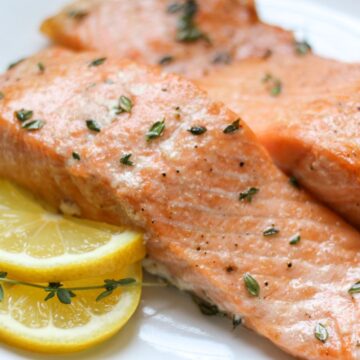
Easy Baked Salmon Fillets
Equipment
- 1 large baking pan
- parchment paper
- meat thermometer
Ingredients
- 2 (about 1 pound) salmon fillets
- 1 Tablespoon olive oil
- 1 teaspoon fresh thyme leaves, or dried
- ¼ teaspoon garlic powder
- ¼ teaspoon salt, to taste
- ¼ teaspoon black pepper, to taste
Instructions
- Preheat oven to 400°F. Line a baking pan with parchment paper.
- In a small bowl, mix 1 Tablespoon olive oil, 1 teaspoon fresh thyme leaves, or dried, ¼ teaspoon garlic powder, ¼ teaspoon salt, to taste, ¼ teaspoon black pepper, to taste.
- Pat dry salmon fillets with a paper towel. Place the fish with the skin side down on a prepared pan. Brush the fillets with the olive oil and seasoning mix.
- Bake it for about 15-20 minutes, until the salmon the internal temperature reaches 145°F and the fish flakes easily with the fork.

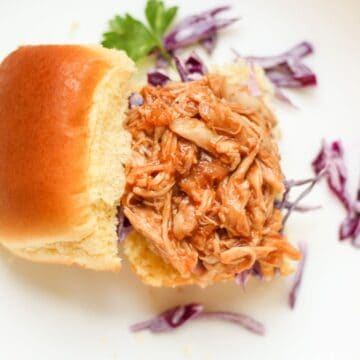
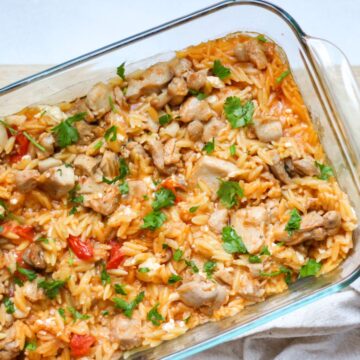
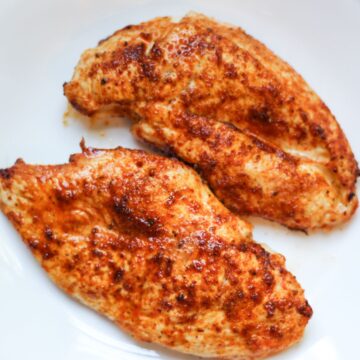
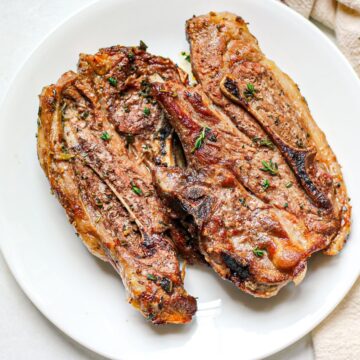
Comments
No Comments